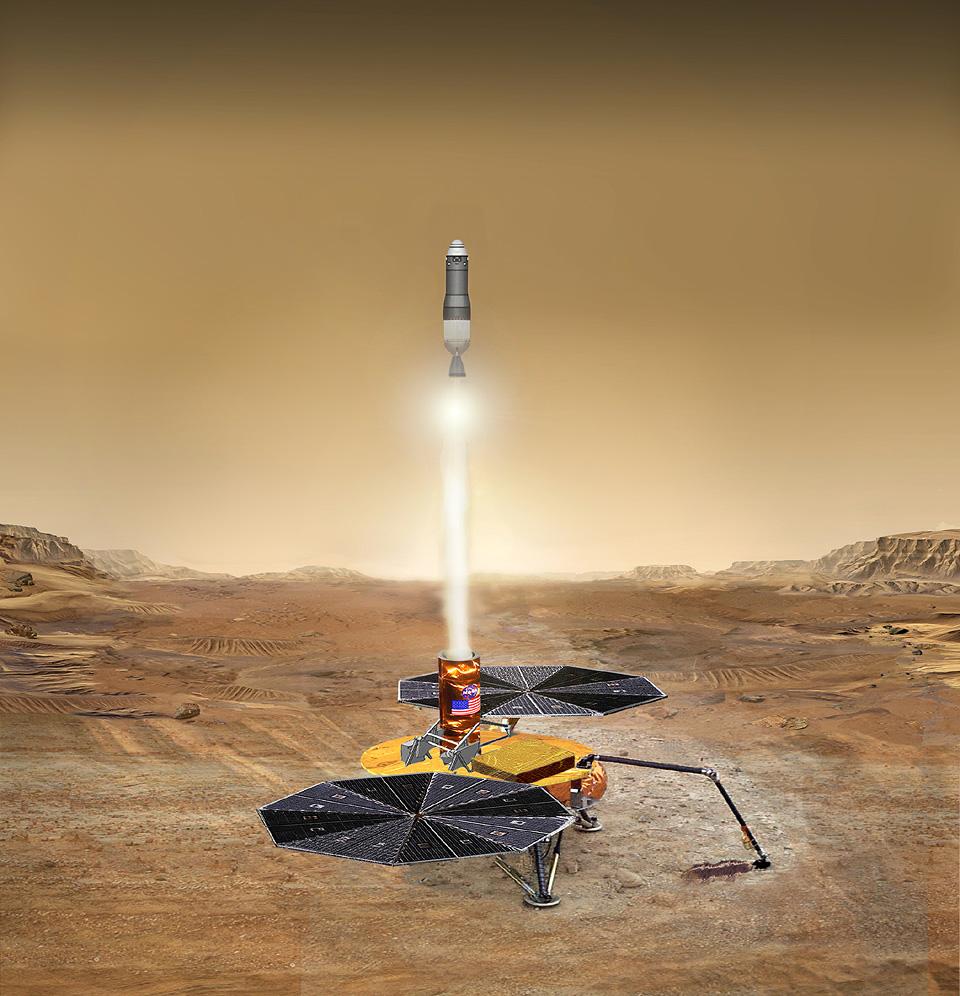
NASA is examining options to launch a robotic mission as soon as 2026 to pick up rock specimens from the surface of Mars and bring them back to Earth, moving forward the timeline for a sample return mission as the agency postpones plans for a new Mars reconnaissance and data relay orbiter.
The sample return project is expected to cost several billion dollars, but the head of NASA’s science division said Monday that international or commercial contributions to the effort could reduce the U.S. government’s expense.
Thomas Zurbuchen, associate administrator of NASA’s science mission directorate, outlined NASA’s thinking in a presentation Monday at a National Academies meeting chartered to review the agency’s progress achieving high-level science priorities identified in a 2011 decadal survey report.
He called the revamped sample return concept a “leaner architecture” than missions NASA previously studied. Setting a launch date as soon as 2026 goes “straight for what I would consider the jugular issue, which is how to land and take off the planet.”
The last decadal survey report ranked a Mars sample return as the highest priority in planetary science. NASA will get started on the multi-mission program with the launch of the next Mars rover in July 2020.
While each Mars rover is fitted with an expanding array of miniature lab technology to conduct on-site rock analyses, instruments like scanning electron microscopes and synchrotrons are much too big to fit on an interplanetary spacecraft. Any discovery of past life on Mars, if it existed, is more likely to come from a ground laboratory.
The Mars 2020 rover will collect vials of soil and rock specimens and deposit them in sealed containers on the ground for retrieval by a future mission.
The next step would be to dispatch a lander to Mars with a small rocket booster to launch a carrier module with the surface samples back into space. The lander may also carry a fetch rover to pick up the sample tubes left behind by the Mars 2020 mission, or the Mars 2020 rover itself — if still operational — could load the specimens into the rocket, called the Mars Ascent Vehicle.
Proceeding with development of a Mars Ascent Vehicle and fetch rover for a launch in 2026 will strain NASA’s planetary science budget.
The multibillion-dollar Europa Clipper mission is scheduled for launch in the early 2020s to make dozens of low-altitude flybys of Jupiter’s ice-covered moon, and NASA is also studying a Europa lander that could launch later in the decade. Europa Clipper is an approved mission, while the lander is still awaiting a go-ahead from NASA Headquarters.
Moving up a Mars sample return mission will likely push back the launch of a new orbiter to the red planet. NASA has studied the proposed orbital craft, tentatively named Next Mars Orbiter, or NEMO, more than two years, but the orbiter never went beyond the conceptual phase.
NASA officials previously discussed launching the orbiter in late 2022, the next Mars launch opportunity after Mars 2020’s launch. That is no longer likely to happen.
“2022 is probably off the table,” said Jim Green, director of NASA’s planetary science division, in a recent interview with Spaceflight Now. “It would be too difficult to pull something together — that is an orbiter that has all the features that we had initially studied.”

NASA considered two main objectives for the planned orbiter.
One goal was to relay radio signals between Earth and the fleet of rovers exploring the Martian surface. Fitted with an optical communications package, the orbiter would have the capacity to transfer rover science data at significantly higher rates, while replacing the relay capability currently provided by an aging orbiter constellation.
NASA also looked at attaching a sharp-eyed telescope to the orbiter to continue high-resolution imaging and mapping now provided by the Mars Reconnaissance Orbiter, which arrived at the planet in 2006.
“That high-resolution imaging is absolutely essential for anything that we need to put down on the ground, to get the imaging necessary to ensure a safe landing,” Green said. “It’s a fundamental feed-forward instrument, in addition to all the science that it does.”
NASA’s Mars Odyssey orbiter is even older, now in its 16th year of operations.
The MAVEN science orbiter arrived at Mars in 2014 and hosts an Electra relay radio payload to connect ground controllers with Mars landers, and NASA provided Electra radios for the European Space Agency’s ExoMars Trace Gas Orbiter, which has been circling Mars since October 2016.
MAVEN and TGO are not in optimal orbits to accommodate regular passes over NASA’s rover landing sites, but officials are considering adjusting MAVEN’s orbit for more favorable relays, a decision researchers say would sacrifice some of MAVEN’s scientific output on the Martian atmosphere.
Engineers could theoretically communicate directly with Mars rovers from ground-based antennas, but the signals would be dropped when the landing sites face away from Earth during each Martian day. Bits of science data, including high-resolution imagery, would also take longer to reach Earth via a direct link.
MRO is expected to run out of fuel by 2024 or 2025, Green said.
“You can’t stop it, and that ends the mission,” Green said. “Then that ends our high-resolution imaging, and then that ends our relay. Those are critical things we want to do, but we can’t do everything either. We also want to bring samples back.
“That requires a Mars Ascent Vehicle,” he said.
Filmgoers who saw The Martian, a 2015 movie about an astronaut stranded on the red planet, are familiar with a Mars Ascent Vehicle. A sample launcher that could be ready to go to Mars in the 2020s will be much smaller than the rocket featured in the film.
“The Mars Ascent Vehicle that they had, I would die for that one, but we don’t have any at the moment,” Green said. “And Mars is a different planet. We’ve got to get off of it, and the way to do that is to start with smaller systems that can take a few kilograms of samples off the surface and get it up to an altitude where we can capture it and bring the samples back. That’s tough. So we also have to invest in concepts in that area.”
The retrieval mission must also land near the samples cached by the Mars 2020 rover, requiring precision landing technology.
Once the samples are hurled into orbit around Mars, another spacecraft would rendezvous with the carrier to retrieve the specimens for return to Earth.
Zurbuchen suggested an international or commercial partner could build the craft to shepherd the samples back. NASA has not decided whether the capsule containing the Mars material will head directly to Earth, or potentially loiter in an orbit near the moon, where astronauts aboard a planned deep space station could collect the samples for return inside an Orion crew capsule.
In his presentation Monday, Zurbuchen said a sample return mission launched in 2026 could be mounted without sending a new orbiter to Mars. MAVEN and Europe’s TGO mission have enough fuel to last beyond 2026, and the Earth return craft sent to Mars to bring the samples home could also carry a telecom relay radio.
Mars advocates have highlighted the need to extend NASA’s Mars telecom relay capacity after the current orbiters are gone.
“Assuming Odyssey ends by 2020, NASA will have MRO and two sub-par options for relay (in terms of their orbits, not their communications ability),” Casey Dreier, director of space policy at the Planetary Society, wrote in an email to Spaceflight Now.
“If their internal analysis says that they can rely on that setup through the mid-2020s, then I believe them, but then they must pursue a sample return mission as soon as possible in order to be able to depend on these aging assets,” Dreier wrote.
Read the Planetary Society’s official statement on the sample return mission concept.
If the sample return mission launches later in the 2020s, NASA may need to re-examine the architecture introduced Monday, Zurbuchen said, perhaps in favor of developing an orbiter first.
“Given that 2022 seems to be ‘out’ for an orbiter, and that NASA seems to be angling for a sample return mission instead of a telecom orbiter anyway, the impetus shifts for sample return to begin as soon as possible in order to take advantage of the existing telecom capability,” Dreier wrote.
Dreier said he is “generally supportive” of the plan presented Monday by Zurbuchen.
“But in a practical sense, the orbital Mars community will be facing tough times ahead with a dearth of missions for at least the next decade, if not more,” he wrote.
There is still an opening for another Mars orbiter that could launch by 2026. Competitions for relatively low-cost Discovery-class robotic interplanetary missions occur every few years, and scientists are free to propose a Mars orbiter.
But such a mission would need to have a compelling scientific rationale, with telecom relay only a secondary concern. A Mars mission would also compete against proposals for probes to the moon, comets and asteroids, and other planets.
Zurbuchen said NASA is also looking at purchasing Mars communications relay services from the private sector. NASA issued a request for information from industry in 2014 seeking ideas for how the agency could use commercial providers for Mars telecom.
SpaceX chief executive Elon Musk said last month his company was interested in working with NASA on Mars communications. Meanwhile, SpaceX’s plan to launch an unpiloted Dragon capsule in 2020 to land on Mars has been postponed, or perhaps scrapped entirely, as the company redefines the way it seeks to send commercial transporters with cargo, and eventually humans, to the red planet.
NASA is eyeing a government-funded human mission to Mars in the 2030s, assuming the agency can secure a budget for the project.
Green said NASA is weighing several ideas it received in the 2014 request for information on commercial Mars relays, but he stressed that potential commercial partners must be ready to meet the agency’s requirements.
“We’re considering a couple of those things, and that needs to be folded in,” Green told Spaceflight Now. “Commercial activities need to be folded in to the best of our ability, but I have to tell you they have to be realistic and they have to actually execute.
“There is a lot of talk about these kinds of things, but guess what? We’re the ones going to Mars. We’re the ones that are landing on Mars. We know how hard Mars is. ESA knows how hard Mars is. This doesn’t make it easy, so the more the merrier. We love the partnerships, but everybody has got to follow through to have these kinds of things come to fruition.”
In reference to relying on a commercial transporter to bring Mars samples back to Earth, Zurbuchen echoed Green’s concerns, saying there will be “no compromise” on the agency’s stringent cleanliness and planetary protection standards aimed at ensuring the specimens are not contaminated on the trip home.
Email the author.
Follow Stephen Clark on Twitter: @StephenClark1.



